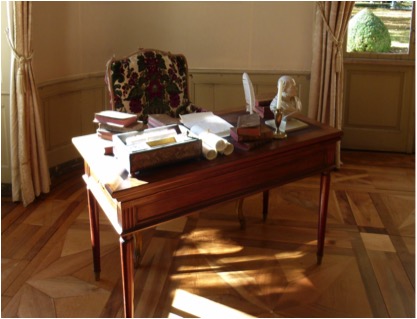
The Battle of Zama between the Romans and the Carthaginians (202 BC) is included in Polybius’s history. Engraving by Cornelis Cort, 1567.
Voltaire’s universal history
Upon hearing the words ‘universal history’ we could be forgiven for thinking it an impossibility, or at the very least, a foolish idea. After all, if an author did somehow succeed in writing a narrative of everything that has ever happened, would it not just be an incredibly long and boring series of sentences in form of ‘And another thing… And another thing…’? This ambitious genre is thought to have originated in Ancient Greece. Polybius, a historian of the Hellenistic period, declared his intention ‘to write general history’,[1] placing the start of his narrative towards the end of the third century BC. He cites Ephorus, a historian writing in the fourth century BC as a key influence on his work and the first writer of what we would call universal history. The genre then flourished during the Roman wars and conquests of the first century BC. Early universal histories, among which we might even count the Hebrew Book of Daniel, tended to be chronicles of the rise and fall of empires, the deeds of great men, various wars between major civilisations and periods of political change.
It should therefore come as no surprise that this genre had something of a renaissance during the Age of Enlightenment, or indeed that Voltaire should want to write his own universal history, encouraged by Madame Du Châtelet’s disdain for traditional histories. Entitled Essai sur les mœurs et l’esprit des nations (OCV, vol.21-27), Voltaire’s universal history is one of his less accessible works purely because of its sheer length and the breadth of information it conveys. This was the longest work he ever undertook, written over at least fifteen years and published for the first time in 1756, after which date the philosophe continued to revise and add to his text right up until 1775. Four years before his death, he authorised the definitive version upon which the Voltaire Foundation’s edition is based.
The good news is that Voltaire does as much as he can to ease the reader into the rather heavy subject matter of universal history. Chapters are broken down into sections and subsections, each with helpfully descriptive titles (e.g. ch.1 De la Chine, de son antiquité, de ses forces, de ses lois, de ses usages et de ses sciences). He returns to overarching themes several times and frequently recaps things he has said much earlier on in the work. Above all, the style of the Essai is a notable departure from that of other universal historians who preceded him. Voltaire’s history is less of a declamatory sermon and more of a fireside chat, interspersed with anecdotes, asides and even jokes.

Voltaire’s writing desk in Ferney, where he put the finishing touches to the Essai in 1775 (Château de Voltaire à Ferney).
Read ‘What Voltaire did differently’ to find out how he broke with tradition and changed the genre of universal history. Another useful aid is our ‘Around the world in nine volumes’ map which visually represents the journey of the Essai, complete with chapter references for each of the main countries he discusses. And finally, we examine the role of women in Voltaire’s historical narrative. Given his departure from traditional topics of war and politics that dominate previous universal histories, we might expect a greater importance to be placed on the contributions of women throughout history. The third of our articles ‘Women in the Essai’ asks whether Voltaire rose to this challenge.
[1] Arnaldo Momigliano, ‘The origins of Universal history’, Annali della scuola normale superiore di Pisa. Classe di lettere e filosofia, 12, no.2 (1982), p.533-60 (p.533).
Written by Sam Bailey (currently PhD candidate at Durham) during his internship at the Voltaire Foundation.



